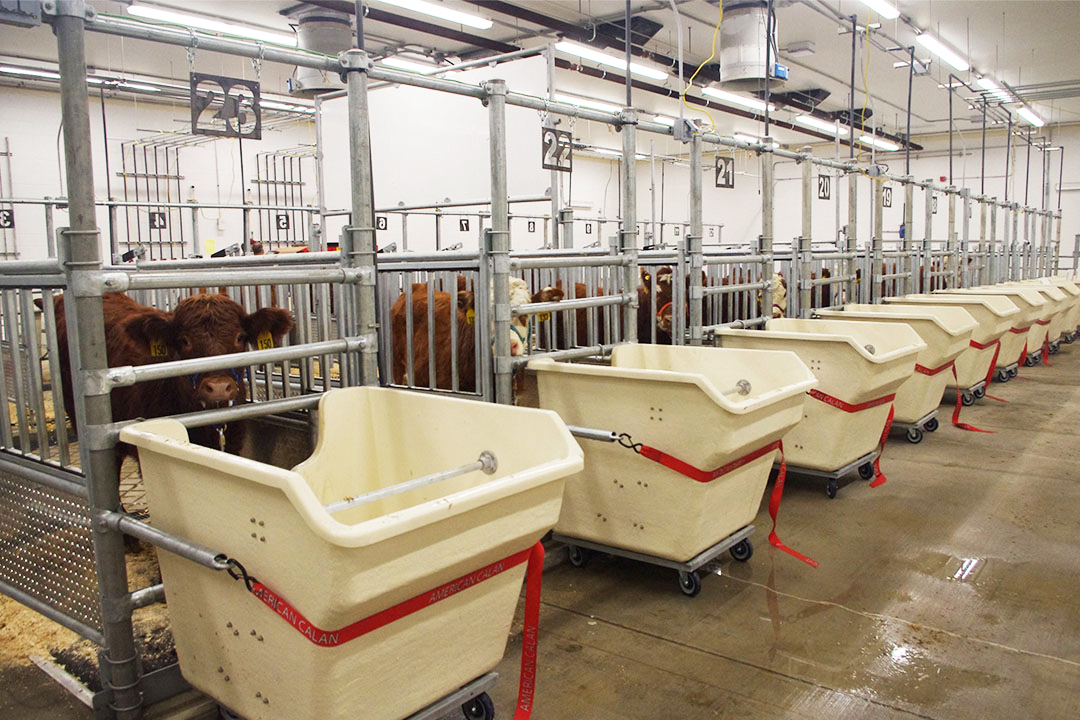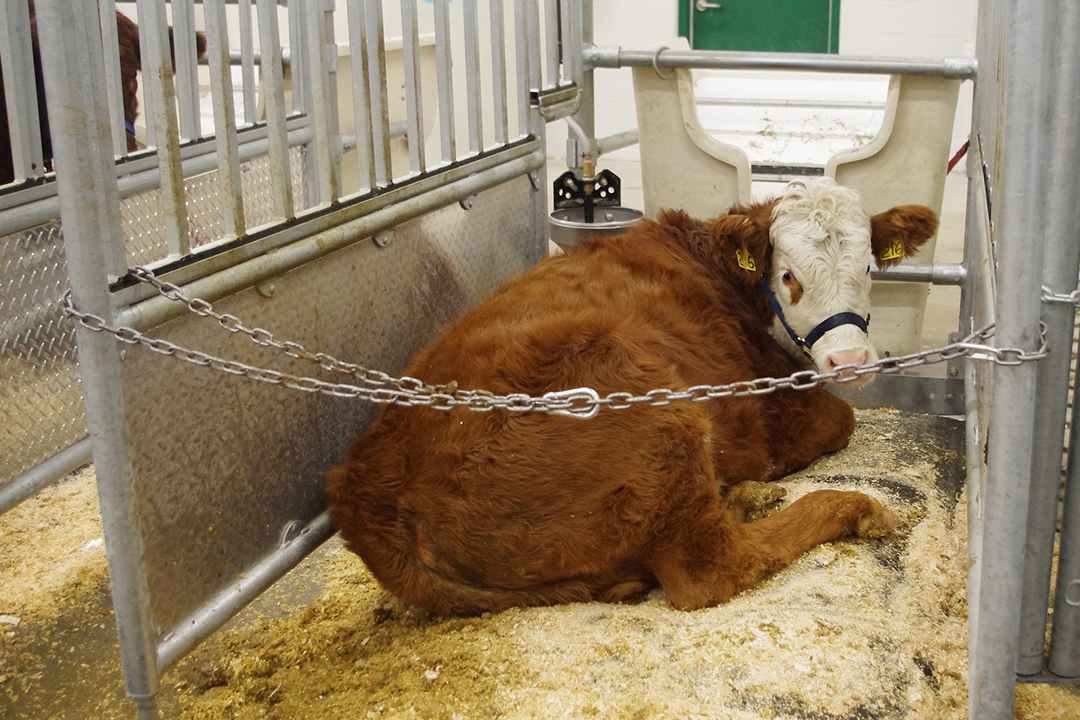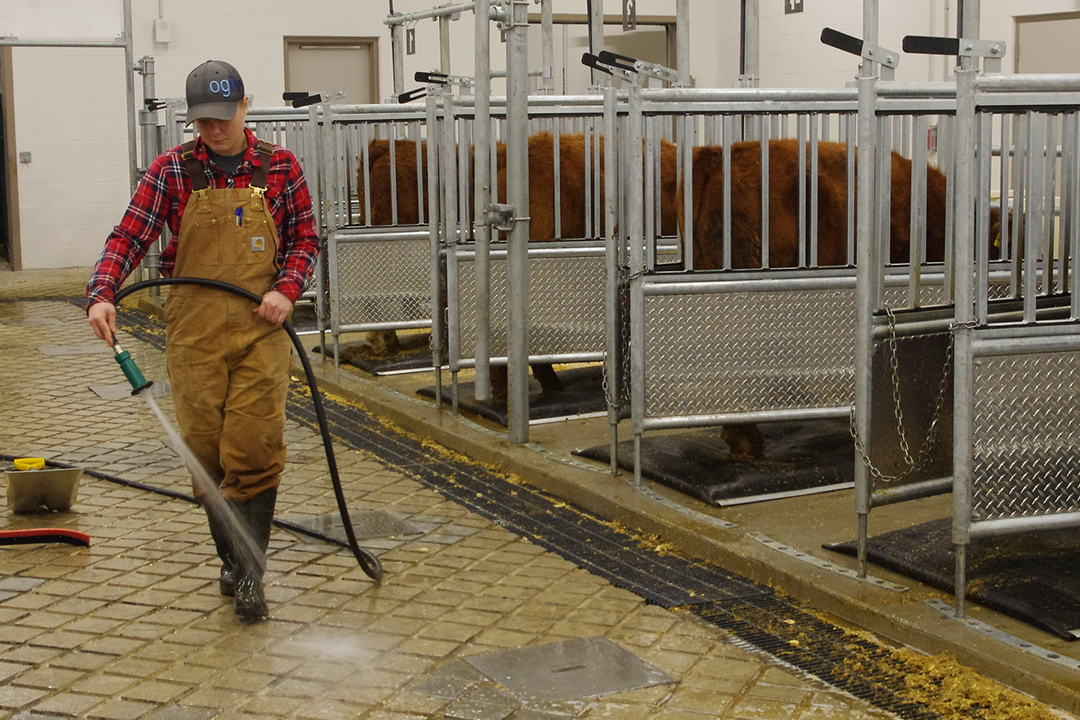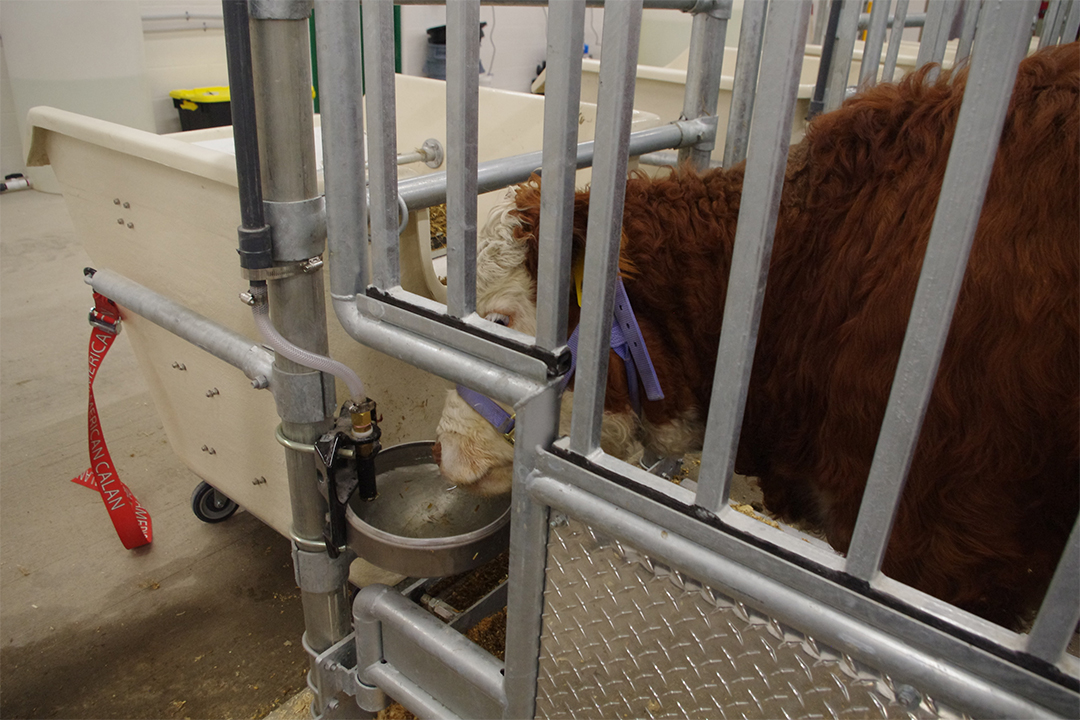
Water quality research first project in state-of-the-art metabolism barn and labs
The first scientific study in the Saskatchewan Cattlemen’s Association Metabolism Barn at the Livestock and Forage Centre of Excellence will identify how different levels of sulphates in water affect beef cattle.
By Lana Haight“A lot of marginal land is used for growing grass and is suitable for raising cattle, but sometimes the only source of water isn’t that great. In some cases, cattle can survive drinking poor quality water, but they won’t necessarily thrive,” said Colby Elford with Saskatchewan’s Ministry of Agriculture.
Elford and Leah Clark, both livestock and feed extension specialists based in Moose Jaw, are leading the sulphate research project that is funded under the new Strategic Field Program through the Canadian Agricultural Partnership (CAP), a federal-provincial initiative. The extension specialists contracted Dr. Greg Penner (PhD), an associate professor at the University of Saskatchewan, to conduct the research.
It’s research that would not be possible without the LFCE’s new barn and adjacent laboratories.
“We can manipulate the quality of water and measure the quantity of water delivered at an animal level, something we can’t do in outdoor pens and something we couldn’t do in our previous facility. And the design of the stalls prevents animals that are side by side from drinking each other’s water,” said Penner, who is also the university’s Centennial Enhancement Chair in Ruminant Nutritional Physiology.
Metabolism barn a “living laboratory”
But the metabolism barn is much more than a barn. It’s a living laboratory that’s unique in all of North America. Within each of its 24 stalls, researchers can precisely measure several factors on an individual animal, including body weight as well as feed and water intake. The stalls make collecting blood, fecal and urine samples safer for the animals and those working with the animals.

The design is intended to support highly detailed and frequent scientific measurements.
“We are trying to understand why things happen and how things happen, not just what happens,” said Penner.
The barn is environmentally controlled to provide a high comfort level for the cows, complying and exceeding guidelines from the Canadian Council on Animal Care.
With infrared cameras installed in the barn, scientists can study animal behaviour in real time during the day and night and in a non-invasive way. They can calculate how much time an animal stands and lies down, how often it changes position as well as the amount of time it spends eating and drinking.
Across the hall from the barn is the sample preparation laboratory, equipped with ample bench space, a fume hood, a centrifuge, water baths, and plumbing of carbon dioxide and nitrogen gas lines.
While this lab isn’t needed for the sulphate study, access to those resources will increase the research that can occur using equipment designed to simulate feed digestion, reducing the number of animals needed for studies and making research more cost effective.
“We will use artificial rumens or rumen fluid within test tubes to digest feed outside the cow to evaluate new feed additives or to better characterize the feed that we are providing. By doing screening outside of animals using models that represent parts of the animals, we are able to narrow down the number of treatments, find treatments that could be winners, and use fewer animals,” said Penner.
The LFCE Beef Cattle Research and Teaching Unit, which includes the metabolism barn and laboratories, provides an enriched learning environment for students who will have opportunities to actually put into practice what they learn in the classroom. Graduate students will spend less time on barn chores, freeing them up to focus on data collection and analysis, and learning how to take their research to the next level by being involved in extension field days for producers.
Sulphate study key to developing water quality guidelines
The main goal for the centre’s research program is improve livestock and forage practices for producers – and that’s why the sulphate study is so critical, say Clark and Elford.
When cattle drink water with high levels of sulphates (SO42-), those sulphates bind trace minerals in the animals’ rumens, which means their bodies can’t absorb the minerals. The consequences can include diarrhea, reduced fertility and milk production, slow growth, a depressed immune system and polio.
The catastrophic results of poor quality water made headlines in the summer of 2017 when 200 cattle died in a pasture near Shamrock, Sask., southwest of Moose Jaw. Researchers determined that the extremely high level of sulphates in the animals’ drinking water contributed to their deaths.
“We have anecdotal evidence regarding water quality. Right now, there isn’t any science to support those recommendations,” said Clark.
Saskatchewan’s Ministry of Agriculture, Alberta Agriculture and Forestry, and Agriculture and Agri-Food Canada post slightly different information on their respective websites.
Saskatchewan’s ”Livestock Water Quality” says the threshold for “unsuitable” water is more than 2,000 milligrams of sulphates per litre while “unsuitable” water in Alberta, according to ”Water Analysis Interpretation for Livestock,” is when the level of sulphates is more than 2,500 mg/L. Agriculture and Agri-Food Canada’s “Water quality impacts on livestock” notes that Canadian water quality guidelines recommend a maximum sulphate concentration of 1,000 mg/L.
This research project is the first step to establishing consistent, science-based recommendations.
In December, the first 70-day trial began with 16 heifers. Each animal is housed in an individual stall with a separate water bowl. Four groups of four heifers each receive drinking water with varying sulphate levels. One group is a control group, receiving water with no sulphates added. The other groups receive water with 1,000, 2,000 and 3,000 mg of sulphates per litre to mimic real levels experienced by Saskatchewan cattle producers.
To determine the impact of water with the different sulphate levels, Penner and two graduate students are taking blood samples at the beginning and end of the study. They are weighing the heifers every two weeks, in addition to recording how much water and how feed each animal consumes.
The researchers will repeat the study with another 16 heifers, starting in March.
For graduate students Brittney Sutherland and Jordan Johnson, working in the new metabolism barn has been a highlight of their studies at the University of Saskatchewan.
“Being a young researcher and doing research at the university for a number of years, it’s exciting to have a new facility that improves our ability to do everyday research. It’s more conducive to doing higher quality research that’s meaningful to the  industry,” said Johnson. (pictured cleaning the barn)
industry,” said Johnson. (pictured cleaning the barn)
Sutherland agrees.
“This research will give results that will directly affect producers. It’s important for me to know exactly what I’m providing cattle. I need to know that what I’m doing is good for their bodies and helping them, not just taking money out of my pocket,” said Sutherland.
“Producers are starting to realize more and more that they need good research to raise cattle in a way that’s beneficial for the animal and economical.”
The Canadian Agricultural Partnership is contributing $82,900 toward the sulphate research. The Roy Romanow Lab, located in Regina, is providing in-kind water testing, estimated to cost $16,200.
Clark and Elford see this project as the first step to improving the well-being of cattle. Once the researchers determine the effects of different levels of sulphates in drinking water, they hope to conduct further research in order to recommend how to properly compensate for elevated sulphates in water by providing cattle with mineral supplements.


